GAYANÉ KHACHATURIAN
P A I N T E R O F D R E A M S Edward Balassanian
Of 8 million Armenians around the world 3 million live in the present-day Armenia. Armenian Diaspora is culturally very rich and diverse. Artists such as painter Arshile Gorky (USA), seascape painter Hovhannes Ayvazovski (Russia), cinematographer Sergey Parajanov (Georgia) are among many prominent names of the international art scene that are from Armenian Diaspora. Gayané Khachaturian, albeit less known, rightfully belongs to this esteemed group of artists. She was born in Tbilisi, Georgia, and lives and works there to date. Gayané Khachaturian’s works are distinctly allegoric. They are inundated with colorful and rich collection of symbols referring to unending parables and metaphors from her personal past and her collective memories of the Armenian community of her native town. On an occasion she has said that many of “the stories” on her canvases are influenced by the tales her grandmother told her in her childhood. Her colorful canvases are reminiscent of such world masters as Marc Chagall, Arshile Gorky and even Hieronymus Bosch of a much earlier era. Chagall spoke of the lives, trepidations, joys and grief of his people in the “Old Country” in a representational manner. Arshile Gorky expressed the same in the abstract—witness, his “How My Mother’s Embroidered Apron Unfolds in My Life…” Gayané is as story-teller as Chagall. However she is much more personal, delving into deep layers of her own psyche and inner feelings. She is reservedly abstract in the use of colors and forms as Arshile Gorky is, and as intriguing in concept and composition as Hieronymus Bosch. Like Bosch, she often “packs” her canvases with personages turning them into “static” scenes—snapshots—each telling a very personal story, expressing a feeling from deep inside.
Her works are “theatrical”. Each canvas seems like a frozen mis-en-scène of a play—a theater scene. Her portraits resemble personages, dressed up and made up, ready to step on the stage. This attribute seems to be under distinct influence of her friend and contemporary, cinematographer and accomplished painter Sergey Parajanov. Gayané Khachaturian has been selected to represent Armenia because she is one of the important links on the “chain” stretching from the depths of history—Armenian illuminated manuscripts of the Middle Ages—to the present day. Her colors, composition concepts and the “story-telling” are all in concert with the roots and branches of the same tree. While Armenian illuminated manuscripts depict the stories of the Gospel, Gayané tells stories of mostly personal and delicate emotions, and often communal issues and concerns.
It is noteworthy that selection of Gayané Khachaturian has independently coincided with the 53rd Venice Biennale Director and Curator Daniel Birnbaum’s intent to “explore strings of inspiration that involve several generations and to display the roots as well as the branches that grow into a future not yet defined”. There is a wealth of Armenian artists—Arshile Gorky, Yervand Kotchar, Martiros Sarian, Minas Avetissian and others—who tie Armenia to its past and form the source and the basis whence contemporary Armenian art feeds and on which it lays foundation.
Gayané Khachaturian is one of the few artists still living, who belongs to and represents this invaluable “procession” of treasures.










